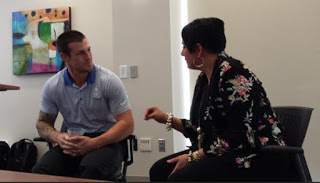Two activists in recovery say addiction doesn’t discriminate (one says recovery does), say it should be treated as a chronic disease

Alex Elswick and Ashley McCarty Dufour talked about their addiction, recovery and activism. (Photo by Melissa Patrick)
—–
By Melissa Patrick
Kentucky Health News
The shared message of two Kentuckians in long-term recovery during a discussion about addiction, recovery and activism at the University of Kentucky was that addiction doesn’t discriminate – but one said recovery does.
Alex Elswick of Lexington and Ashley McCarty Dufour of London told a room full of health advocates about their struggles with addiction – Elswick to heroin and Dufour to methamphetamine and opioid painkillers – that started with prescription opioids. They talked about their rocky roads to recovery and said they’ve been “clean” for almost six years.
Another thing they had in common is that they came from stable, loving homes and had families that supported them.
“I was born in a middle-class, well-known family in Laurel County. People like that don’t have children who are addicted to drugs – but they do,” said Dufour, a community liaison for Addiction Recovery Care. “Addiction does not discriminate.”
Yes, but recovery does, said Elswick, co-founder of the UK Collegiate Recovery Community and an extension specialist for substance-use prevention and recovery at UK.
Elswick explained that because of his “privilege,” which he acknowledged was a term many are uncomfortable with, he had had all kinds of “recovery capital” available to him – his parents’ church found him a home, one of his father’s patients found him a job, and he was able to see a therapist for his anxiety disorder because he had insurance. “The list just goes on and on,” he said.
“Recovery does discriminate,” he said. “There are huge disparities in access to resources in terms of race, socioeconomic status, in terms of sexual orientation.”
Elswick said it was this realization that prompted him to focus his doctoral research at UK on long-term recovery for substance-use disorder. He focuses on “recovery capital,” defined in a white paper on the topic as “the breadth and depth of internal and external resources that can be drawn from to initiate and sustain recovery from severe alcohol and other drug problems.”
Elswick said the resources are in three main areas: personal, social, and community.
“What my experience taught me, and what subsequent research has taught me, is that people like me, people who come from really fortunate backgrounds, are able to leverage an immense amount of resources when the time comes to recover,” he said.
Elswick, who is also the co-founder of Voices of Hope, said the organization offers recovery coaches who help people in recovery determine their available “recovery capital,” then helps them figure out how to fill in the gaps, like finding safe housing or job training.
DuFour and Elswick spoke at an event sponsored by UK College of Public Health during National Public Health Week, in the first week of April.
Another shared topic was the importance of meeting people in addiction wherever they are, and treating it as a chronic disease like diabetes or high blood pressure.
Dufour said that in her work as a peer-support specialist with several syringe-exchange programs across the state, it’s important to “meet them where they are,” whether that is to make sure they are using clean needles to keep from spreading infectious diseases, like hepatitis C and HIV, to offer them access to screening and treatment for these diseases, or to help them get into treatment.
“IV drug users are five times more likely to enter treatment through a syringe-exchange program,” Dufour said. “Five times more likely. Why? Because that’s that population that nobody is touching. Nobody is talking with them. But when they come in, somebody is loving on them and caring about them and giving them hope, so they are five times more likely to go into treatment.”
Dufour said Addiction Recovery Care offers peer support in 16 counties with syringe exchanges, and in those locations, 75 people have entered treatment in the last six months.
Elswick spoke at length about the “false dichotomy” that the only way to help someone in addiction is treatment. Rather, he said, you have to meet them where they are.
For example, he said Voices for Hope’s telephone recovery-support program isn’t clinical in nature and isn’t meant to push treatment, but offers a safe place for someone in addiction and recovery to get help with their issue of the day.
“The intervention is the phone call,” he said, adding that the program, like syringe exchanges, also serves as a touch point for those in addiction that provides them with a safe place to turn to when they are ready for treatment.
Elswick suggested that the concept of meeting someone with an addiction where they are is becoming accepted but has a long way to go. He said it’s important to keep the doors open at other points of contact, such as arrest, jails and emergency rooms, as a way to help get people into treatment when they are ready, since they may not be ready at the initial point of contact.
And as he often says, the most important takeaway to remember is: “Addiction is a chronic disease.”
He said the traditional approach to addiction care, treatment of 30 to 90 days with no support other than a pamphlet on how to follow a 12-step program upon discharge, is a recipe for relapse.
“It’s because we are mismanaging a chronic disease with acute care,” he said.
Like any other chronic disease, Elswick says that if we want to improve recovery success, people with addictions need recovery support services for their lifetime, “so that we can match their chronic disorder with chronic disease management.”